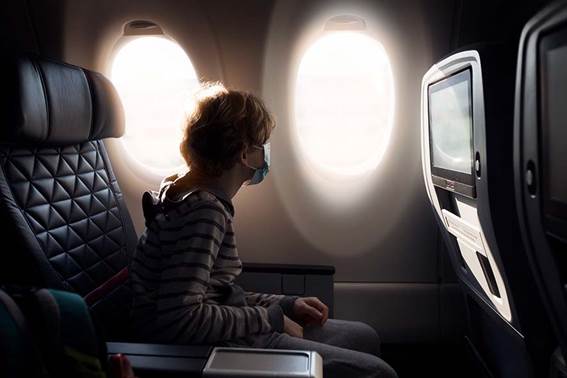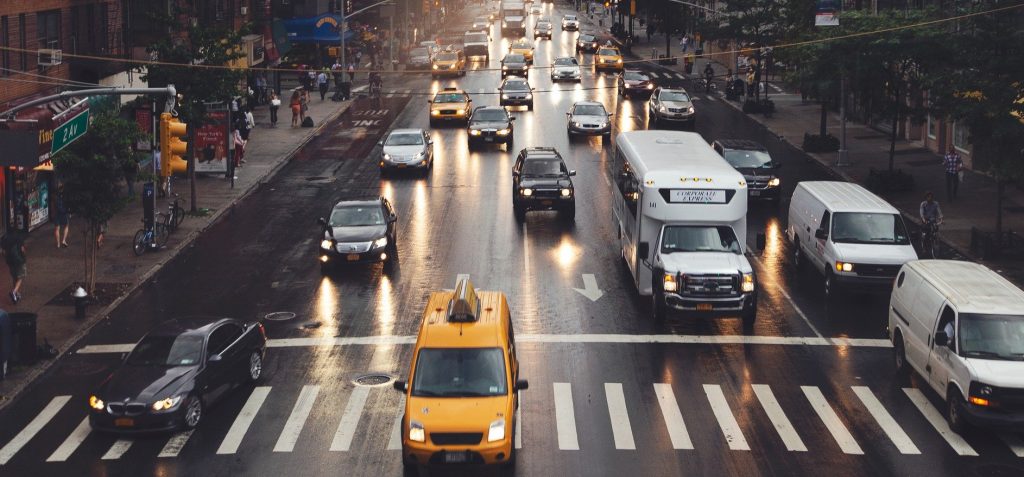To keep air travel alive and well in the age of social distancing and environmental responsibility, carriers and aircraft manufacturers must rethink how they do business. That will require more investment and new paradigms.

As governments announce ambitious vaccine rollouts, aviation experts predict the resulting boost in public confidence will fuel a recovery in the airline business. “A vaccine is on the horizon, and travelers are already feeling more optimistic about flying in 2021,” wrote Jessica Puckett, a journalist for Condé Nast Traveler, in December.
Online flight searches and bookings on platforms such as Skyscanner and Kayak increased by more than a quarter in the wake of “promising vaccine news,” Henry Herteveldt, a travel industry analyst at Atmosphere Research Group, told The Today Show in January. “Our research shows 84% of leisure airline passengers are eager to start traveling again.”
However, it won’t be business as usual. “After a year like 2020, it’s a safe bet to say that air travel will never be the same again,” wrote Puckett. “In an industry that was impacted at every level, countless changes have already occurred in order for airlines to adapt and survive.”
Major losses
The International Air Transport Association (IATA), a trade group representing 290 carriers, estimates the number of passengers dropped to 1.8 billion in 2020 from 4.5 billion a year earlier. “The 2020 figure is roughly the same as 2003,” said an IATA press release. That translates to a $314 billion loss in an $825 billion industry, according to the market research firm IBISWorld. IATA Director General Alexandre de Juniac called 2020 an “annus horribilis” for aviation.
Meanwhile, the U.S. government’s Bureau of Transportation Statistics said the planes that continued to fly were operating at 59% capacity, compared to 85% in 2019. Five airlines in the U.S. alone declared bankruptcy.
Middle Eastern airlines had no more than a total of 50 airplanes in the skies at any one time during 2020, compared to an average of 300 in previous years, according to WorldAware’s Global Risk Forecast 2021. “In the passenger business, we are now at just 18% of the revenues we had last year,” Sir Tim Clark, Emirates airlines president, told Deutsche Welle (DW) in January.
EgyptAir reported that in 2020 it had between 40 and 50 active international flights daily, compared to 100 to 110 before the pandemic. Domestic weekday flights dropped from 40 to 10 a day. That translated to an EGP 7 billion ($446 million) loss from March 2020 to the end of the year.
As a result, the airline froze expansion plans that are part of the national strategy to make Egypt an economic hub for Asia, Europe, South America and Africa. EgyptAir also temporarily halted trips to several destinations in 2020, including Saudi Arabia, Kuwait, Morocco and Algeria.
As of April, EgyptAir announced the resumption of 40 international and domestic passenger flights, with a total capacity of 2,477 passengers. None of them are operating at full capacity in order to comply with World Health Organization social-distancing standards.

Survival mode
In 2020, EgyptAir focused on training staff and updating its fleet. It announced it had taken delivery of 26 aircraft and plans to add nine more in 2022.
The airline also cut ticket prices for domestic flights in half to stimulate sales as part of a presidential initiative to promote domestic tourism. And in March, EgyptAir announced discounts of as much as 40% for all seating classes on international flights to select destinations through May 8.
Other airlines have focused on altering their business models. The simplest was introducing more flexibility in canceling tickets and “nixing inconvenient change and cancellation fees,” wrote Puckett, of CNTraveller, in December. “Flying standby on the same day and putting frequent flyer miles back into loyalty accounts are becoming free benefits, too.”
U.S.-based Delta Airlines created “Peace of Mind Booking,” which waived change fees on all flights, including international trips booked before the end of March. United Airlines has a similar program, though it doesn’t apply to economy class. The airline also created flight credit, where travelers can cancel and rebook a flight once for free, in addition to travel credit that uses miles to determine benefits. Lastly, American Airlines began applying discounts to domestic and North American flights as of September 2020.
Scott Keyes, the founder of Scott’s Cheap Flights, told The New York Times in March that “airlines are trying to do anything they can to engender goodwill among travelers, but also to try to hold onto travelers’ money.”
Airlines also had to invest in more direct flights to remote and non-touristic destinations and business hubs to quickly adapt to the needs of expats looking to return home after months of lockdowns. “We see the trend of travelers looking to visit friends and relatives continuing into 2021,” Paul Starrs, senior vice president of the western region for Qatar Airways, told CNTraveller in December. “There are still millions of people who have not been able to reunite with their friends and families due to the pandemic and as a result, we can expect to see diaspora populations continuing to travel in a bigger way.”
For regional airlines, that was a vital revenue lifeline last year. “What started as demand for specially coordinated repatriation flights for those stranded abroad … became the inspiration for lucrative new international routes,” wrote Puckett of CNTraveller. “Now, carriers around the globe are shaping new route launches around this demographic.”
Emirates and other airlines focused on repurposing passenger planes to fly cargo. “Our cargo revenues have gone through the roof,” Clark of Emirates told DW in January. “We exceeded revenues from last year when the entire fleet was flying.”
Cargo freighting accounted for as much as 80% of Emirates revenues at various points throughout 2020. By the end of the year, it represented 60% of profits, up from 10% in 2019. “Cargo is really what is keeping us going,” said Clark. “We are getting very bizarre requests for bespoke cargo operations … It is highly lucrative because they are paying top dollar.”
Raising confidence
Vaccine rollouts across the world are opening some travel doors and corridors on which airlines could capitalize, but first, travelers must have confidence in onboard safety measures.
To that end, airlines require passengers to go through new test regimens and save their vaccination status on certified smartphone apps for verification before boarding. “I feel like airlines are starting to get the hang of [new safety protocols], and the more measures they add, the more they can unlock a demographic of passengers who were previously wary and who will say, ‘I can work with that,’” said Alex Macheras, a London-based aviation analyst.
Several airlines are considering allowing only those with proof of vaccination to fly in 2021. “We are looking to change our terms and conditions to ask international travelers to have a vaccine before they get on an aircraft,” Qantas CEO Alan Joyce said in a television interview in December. “Whether you need that domestically, we’ll have to see what happens with COVID-19 in the market. But for international visitors coming out and people leaving the country, I think that’s a necessity.”
Experts believe it is an inevitable shift. “Just as proof of a negative COVID-19 test is becoming standard for travel on certain airline routes, proof of a vaccine could become as important as a passport when flying some international routes,” wrote Puckett.
Several smartphone apps that record such information are certified by airlines, including CommonPass, Verifly and AOKpass. “It’s a digital health passport showing test results and vaccination status,” explained Herteveldt of Atmosphere Research Group.
Conditional recovery
Establishing a reputation as a safe airline that can reach anywhere in the world with minimum hassle would prove invaluable. “Everyone has that bottled-up energy to do that one big trip,” Megan Spurrell, CNTraveller Association editor, told the Today Show in January. She added that travelers don’t worry anymore about lockdowns or infections disrupting their holiday plans because airlines waive cancellation and rebooking fees.
“Ask any airline CEO for a prediction and you will receive answers of cautious optimism,” according to Puckett. Lufthansa CEO Carsten Spohr talking to Germany’s Wirtschaftswoche magazine in December: “I am sure we will see a significant upturn in the course of next year.” Spohr believes his airline will achieve 70% of 2019’s passenger level by summer and 100% by early next year.
Juniac of IATA told DW in January said that “2021 will be a better year,” in that losses will be 40% instead of last year’s 66%. Airlines of America, an industry association representing 11 carriers, reported that travel in mid-March was down 53%, compared to 90% at the height of the pandemic last year.
However, that modest recovery still faces several obstacles. “I believe our industry will bounce back … depending on restrictions that may still remain,” Martin Gauss, CEO of Latvia’s flag carrier Air Baltic, told DW in December. Slowly rising ticket prices and fewer free perks as demand rises and economies gradually return to normal will also be factors. Smartphone app Hopper predicts that airfares will increase by 12% starting in May, though they will remain lower than pre-pandemic averages.
Regardless of prices and perks, business travelers are unlikely to return to flying as much as they once did. That is because more companies realize the convenience and economy of scheduling online meetings with team members working at home and abroad.
A decline in business travel could greatly limit airlines’ projected recovery in the next few years. Airlines of America reported that 60% to 70% of pre-pandemic fare sales came from corporate travelers. Prior to the pandemic, the Global Business Travel Association predicted that by 2022 business travel would account for $1.7 trillion annually.
Helane Becker, an airline analyst at Cowen investment bank, told the New York Times in March that business and international travel this year will remain 80% to 90% off pre-pandemic levels. Meanwhile, domestic leisure travel this summer will recover to within 5% of what it was before. “Leisure low-cost carriers will be back to 2019 levels this summer, maybe even a little bit higher,” said Savanthi Syth, an airline analyst at Raymond James & Associates.
In the long run, according to IdeaWorks, an airline and travel-focused consultancy, business travel sales would permanently drop by 19% to 36%. Lufthansa’s Spohr is more optimistic, saying permanent business travel losses would range from 10% to 20% and leisure travel would account for 75% to 80% of revenue as a result. “This would pose a fundamental problem for the airline sector, which has made a comfortable living off coveted full-fare passengers, enabling it to subsidize other, cheaper fares,” experts told DW in January.
Additionally, not all tourist destinations will benefit equally. Africa, for example, would likely remain a troubling destination for holiday travelers. “If recent activity is any indication, [people] illustrated they are ready and willing to travel,” Naledi Khabo, CEO of the African Tourism Association, told CNTraveller in December. “The key to getting them to travel to African destinations is transparency and instilling trust in safety protocols that have been implemented. Direct and authentic engagement … remains a priority and is critical to Africa’s tourism growth.”
Back to normal?
It is doubtful the airline business will ever return to what it was before the pandemic. “I don’t think things will be totally normal at all, I think that’s very unrealistic by the end of next year,” Southwest Airlines CEO Gary Kelly said in a recent Skift forum. “I think we need to be mentally prepared for a really tough 2021.”
For one, highly lucrative routes to major cities such as London and Frankfurt might be replaced with more vacation destinations in places like Florida and Montana, reported Elaine Glusac of the New York Times in March. “Most carriers are announcing new service to leisure destinations in time for summer and in many cases offering convenient point-to-point service modeled on low-cost carriers, rather than routing fliers through hubs.”
With tens of millions of jobs lost worldwide because of lockdowns, those who can still afford to travel are seeking the cheapest flights. “By the end of the year, there will likely be six budget airlines [in the U.S.] battling for travelers,” Harteveldt of Atmosphere Research Group told The New York Times in March. He cited two low-cost carriers, Breeze Airways and Avelo Airlines, expected to launch this year in America. “The more low-fare airlines, the more low-fare seats available to the public, not just on these airlines but on carriers that compete with them,” he said. That invariably means tighter profit margins.
Making matters worse is that, due to social distancing and other preventive measures still required on airplanes, the number of passengers allowed will be cut nearly in half. The number of scheduled flights will shrink due to sanitization requirements after each trip, fewer ground crews at airports and airlines requiring proof of vaccination. Investment bank Cowen sent a memo to airlines stressing that the best scenario “is a [nearly] 50% recovery rate.”
Overcoming the economic and health fallout from the pandemic will take years. Kelly estimated airlines should “look forward to a much better recovery beginning in 2022 and then maybe the possibility that things are normalizing to [pre-pandemic] levels by 2024.”
Amir Eylon, president and CEO of the research company Longwoods, told the Los Angeles Times in February he hopes to see some recovery in airlines during the third and fourth quarters, “barring any unforeseen new challenges to travel.”
Ultimately, it will take a sustained worldwide economic recovery to save the airline industry. Said Clark of Emirates: “The global economy is enormously resilient; it has taken enormous knocks in the past and always bounced back.”







